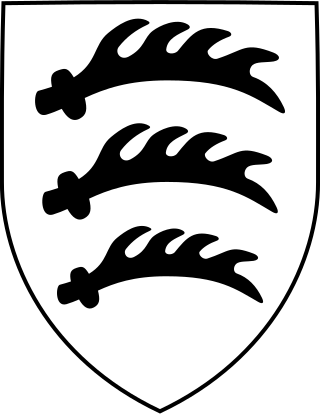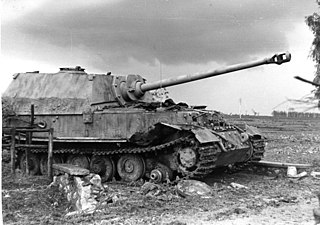
The Jagdpanzer 38, originally the Leichter Panzerjäger 38(t), known mostly post-war as Hetzer, was a German light tank destroyer of the Second World War based on a modified Czechoslovakian Panzer 38(t) chassis.

Panzerjäger is a term used for an anti-tank vehicle, as well as anti-tank units. The term was first used in the Wehrmacht, and also post-war by the German Federal Republic Bundeswehr. The term Panzerjäger was used in the Bundeswehr as a designation of rank.

The Jagdpanzer IV / Sd.Kfz. 162, was a German tank destroyer based on the Panzer IV chassis and built in three main variants. As one of the casemate-style turretless Jagdpanzer designs, it was developed against the wishes of Heinz Guderian, the inspector general of the Panzertruppen, as a replacement for the Sturmgeschütz III. Guderian objected against the needless diversion of resources from Panzer IV tank production, as the StuG III was still more than adequate for its role.

The SS Division Hitlerjugend or 12th SS Panzer Division "Hitlerjugend" was a German armoured division of the Waffen-SS during World War II. The majority of its junior enlisted men were drawn from members of the Hitler Youth, while the senior NCOs and officers were from other Waffen-SS divisions. Most of the enlisted men were teenagers, starting from the ages of 16 or even 15.

The 10th Panzer Division was an armoured division in the German Army, the Heer, during World War II, established in March 1939.

The Flemish Legion was a collaborationist military formation recruited among Dutch-speaking volunteers from German-occupied Belgium, notably from Flanders, during World War II. It was formed in the aftermath of the German invasion of the Soviet Union and fought on the Eastern Front in the Waffen SS alongside similar formations from other parts of German-occupied Western Europe.

The 78th Infantry Division, later known as the 78th Assault Division, was a German infantry formation which fought during World War II. After the 78th Assault Division was destroyed near Minsk in July 1944, the 78th Volksgrenadier Division was created.

The 6th Panzer Division was an armoured division in the German Army, the Heer, during World War II, established in October 1939.

In military history, the German term Kampfgruppe can refer to a combat formation of any kind, but most usually to that employed by the Wehrmacht of Nazi Germany and its allies during World War II and, to a lesser extent, the German Empire in World War I.

The I SS Panzer Corps was a German armoured corps of the Waffen-SS. It saw action on both the Western and Eastern Fronts during World War II.
This is the complete order of battle of Allied and German forces involved during Operation Market Garden.

The 17th Panzer Division was a formation of the Wehrmacht in World War II. It was formed in November 1940 from the 27th Infantry Division. It took part in Operation Barbarossa, the invasion of the Soviet Union in June 1941, and in the winter of 1941–42 participated in the Battle of Moscow. In November 1942, the division was sent to the southern sector of the Eastern Front where it participated in Operation Winter Storm, the failed attempt to relieve the surrounded troops at Stalingrad. The division was held in reserve during the Battle of Kursk in 1943, and thereafter retreated through Ukraine and Poland, before ending the war in Czechoslovakia.

The 25th Panzer Division was a tank formation of the German Army during World War II. It was one of several understrength Panzer divisions formed during the last years of the war.

The 14th Panzer Division was an armoured division in the German Army during World War II. It was created in 1940 by the conversion of the 4th Infantry Division.

The 24th Waffen Mountain Division of the SS Karstjäger was a German mountain infantry division of the Waffen-SS, the armed wing of the German Nazi Party that served alongside but was never formally part of the Wehrmacht during World War II. At the post-war Nuremberg trials, the Waffen-SS was declared to be a criminal organisation due to its major involvement in war crimes and crimes against humanity. Named Karstjäger, the formation was one of the 38 divisions fielded by the Waffen-SS. Formed on 18 July 1944 from the SS Volunteer Karstwehr Battalion, its nominal strength was never more than theoretical and the division was soon reduced to the Waffen Mountain Brigade of the SS. Throughout its existence as a battalion, division and brigade, it was primarily involved in fighting partisans in the Karst Plateau on the frontiers of Yugoslavia, Italy, and Austria; the mountainous terrain required specialised mountain troops and equipment.

Panzer Brigade 150 or SS Panzer Brigade 150 was a formation of the German Army during World War II that was formed to take part in the Ardennes offensive. It was unusual in that it was formed from all parts of the German Armed Forces; the 2,500 men in the brigade were formed from 1,000 from the Heer, 500 from the Waffen SS, 800 from the Luftwaffe and 200 from the Kriegsmarine. It was tasked with the capture of the bridges at Amay, Engis and Huy. The Brigade is known for including English-speaking members wearing American Army uniforms to cause disruption and disinformation behind the American lines. The Brigade was also issued captured Allied equipment and had two Sherman tanks and German vehicles were modified to resemble Allied armoured vehicles.

The 25th Infantry Division was a military unit of the German Wehrmacht. It was later reclassified to 25th Motorized Infantry Division, and in June 1943 to the 25th Panzergrenadier Division.
The 2nd Tank Division was a division of the Red Army and Soviet Ground Forces, which was formed twice under very different circumstances.

The 653rd Heavy Panzerjäger Battalion was a tank destroyer unit of the German Wehrmacht active during World War II. It was equipped with Ferdinand and later Jagdtiger tank destroyers. Elements of the battalion served on the Eastern, Western, and Italian fronts between 1943 and 1945.
The Panzer Division Jüterbog was an armoured division of the Wehrmacht during World War II. Created on 20 February 1945, it was active for a short period of time.
















